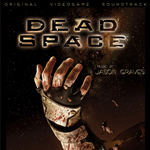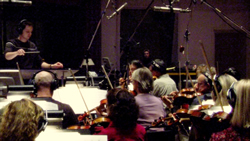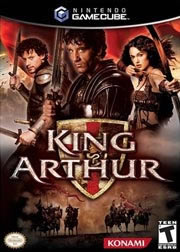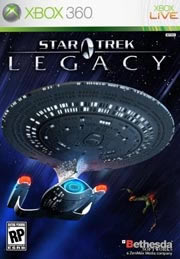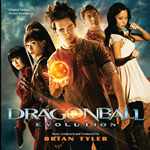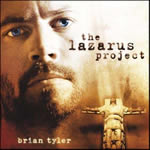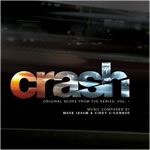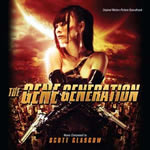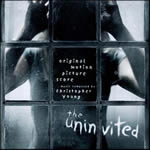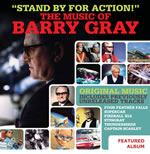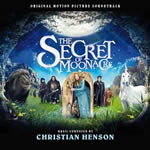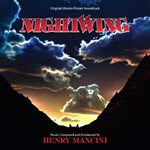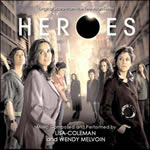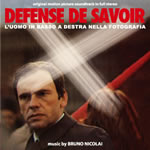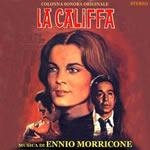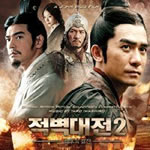 |
Soundtrax: Episode 2009-5
April 9th, 2009By Randall D. Larson
Jason Graves Jason Graves: Video Game & Film/TV Music
Two-time British Academy Award-winning composer Jason Graves has scored more than 150 commercials, television shows, video games, movie trailers, and feature films, conducting orchestras at Capitol Records, Paramount Pictures, Skywalker Sound, Seattle and Salt Lake City. His score to last year’s video game Dead Space was honored with a BAFTA Award for “Use of Audio” (sound effects/dialog/original score) from the British Academy of Film and Television and also took home the coveted “Audio of the Year” and “Sound Design of the Year” awards at the 7th Annual Game Audio Network Guild Awards last month. This year's awards mark seventeen G.A.N.G. nominations and four wins for Jason's music over his seven year career in games.
I interviewed Jason recently about his approach to scoring films and games, and his experiences so far in the industry.
Q: You studied under several notable film composers –- Elmer Bernstein, Christopher Young, Jerry Goldsmith. What did you learn from them that you are now able to apply as a working composer for film, television, and game music?
Jason Graves: There were obviously many, many wonderful things I learned from each one, but all three had a similar motivation behind their work. They were absolutely obsessed with learning new things and becoming better composers. All three of these guys were at the top of the A-list –- they didn't really have to do anything but sit around and wait for the next gig. But it wasn't about the money for them –- it was about the music. It was about their relationships with the producers and directors. It was about composing the best music they possibly could and always second-guessing themselves, in a good way.
I try to live by their examples with every new project I take on. I look at each opportunity as a chance to make myself a better composer, learn something new and try something I hadn’t tried before.
I think it's fair to say there's some influence from both Jerry Goldsmith and Christopher Young in the score to Dead Space. I really love Jerry's rhythmic style, especially being a classically trained percussionist. All those odd meters bouncing around and syncopated rhythms lend themselves to being unpredictable and catching the listener off guard. There's a lot of that “where’s the beat?” kind of writing in Dead Space.
There's also a wonderful sense of immediacy and urgency that Jerry had with so many of his horror scores, like Alien and Poltergeist. I wanted to convey that same sense of dread and fear in the score for Dead Space. Hopefully what players hear will grab them and put them on the edge of their seat, even if they don’t even realize they’re listening to “music” in the game.
Chris is another master at psychological suspense. A few of his film scores were early examples of the direction EA suggested for this score. In the end I found many of the “source” pieces Chris had used as inspiration for his scores – the 20th century experimental classical pieces I was talking about earlier. It turns out I used many of the building blocks and ideas that Chris has used in several of his film scores, although I treated them differently because of the interactive requirements of the game’s score.
Q: How did you hone your craft at scoring during your early experiences in Hollywood and television music? What did you learn – and what would you pass on to other up-and-coming composers?
Jason Graves: I spent a lot of time under extremely tight deadlines with lots of music getting composed every day, seven days a week. I know that’s a fairly typical thing in my line of work, but I was still in school at the time and was immediately thrust into it full speed ahead. No internships or assistant positions – just straight into full-time composing. As a result, I ended up packing in a lot of experience and work into my time in Hollywood. I learned to compose very quickly and on a specific schedule. By the time I was finishing up the last of my television shows, I could score an entire episode (around twenty minutes of music) in a few days, with only a few corrections, if any, from the producer.
I think I learned to listen really well, and hear what the producer was asking for. That’s an ability that has taken me further than anything else. People like to work with other folks who “get it,” and most of the time it’s just a matter of shutting up and letting them explain what they want. Not to say I don’t offer my opinion, but I’ve found producers are a lot more willing to listen to other ideas if they’ve had a chance to explain their own.
As far as passing advice to up-and-coming composers, I would say write as much music as you possibly can, whether you’re getting paid for it or not. Nothing can make up for lack of experience – the more music you compose the more you learn. Study as much sheet music as possible, especially classical pieces if you are composing orchestral music. Orchestration is just as important as melody and harmony, especially if you are doing your own MIDI orchestra pieces. Never stop learning – never stop listening. Try to make yourself a better composer with every piece you work on.
Q: How did you come to compose music for video games?
Jason Graves: My background is in classical composition and scoring for film and television. I was approached about seven years ago because of my experience composing and conducting for live orchestra. My first game had a decent budget for a live orchestra and I ended up having a blast, both working on the game and working with the audio team. After that first title I was hooked. I was already an avid gamer and it seemed the game music industry was really starting to take off. From then on I switched my focus from film and television to video games.
Q: What kind of skills do you find unique to scoring games, as opposed to television or feature films?
Jason Graves: Video game soundtracks can be tricky if you’re not careful. On one hand, there’s a lot more freedom than working on a film. Other than general instrument/mood guidelines, I have total freedom to create whatever music I think would work the best for that specific scene in the game. On the other hand, I have to work harder to keep up the excitement and “cinematic” quality of the music, especially to avoid the dreaded “video game loop” curse.
Also, people may watch a film a few times and hear the score once or twice – the whole film is maybe two hours long. In contrast, even “short” games provide at least 10-12 hours of gameplay. I have to compose with the idea that players are going to hear my music a lot more than they would a conventional films score.
Q: What is the responsibility of music in a video game – as opposed to a non-interactive experience like a movie or a TV show? How has this responsibility changed over the years, as we’re now seeing fully orchestral game scores emerging as fully fledged compositions in their own right?
Jason Graves: The first and foremost responsibility of any game soundtrack is to enhance the game experience for the player. Really, it’s the same responsibility as music for film or television. Game music is just finally catching up. My intent is to provide an emotional experience for the player through my music, which honestly is always my intent, no matter what the project is. The most basic musical language is Emotion. If you’re not speaking some sort of language to the listener, why would they bother to even listen? Dead Space had a more unique challenge, in that the music was so often extremely brutal and visceral. I wanted to keep that idea of immediacy and emotion and pull the listener into the world of Dead Space, but also keep the music fresh and new.
I think the biggest way game music has evolved over the years is its ability to adapt and change, almost immediately, with the player’s choices as they play the game. It’s that interactivity that sets game music apart from its siblings – and also what makes it so much fun to compose!
Q: When scoring a video game based on a film, such as King Arthur, Wild Wild West, Zathura or Flushed Away, how have you adapted or contrasted the music of those films into your score for the game? To what extent have you had to stay true to the film music sensibility, and to what extent have you been able to invest your own musical voice into these game scores?
Jason Graves: Each one of these was different, both in the way I approached the score and how the producer or audio director wanted it to sound. King Arthur was my first official game score, and as with most film-based games the producer wanted the score to sound like Hans Zimmer’s score from the film, but Hans hadn’t even finished it by the time I had to have the game score completed. Fortunately, there was an “expected” kind of sound, knowing that Hans was composing the film score, so I kept that kind of sound in mind as I composed the game score. In the end, there were many reviews praising the music in the game, “the epic, cinematic soundtrack, pulled right from the film…” – things like that. Hey, I figure if my music makes them feel like they’re “playing the movie” than I did my job well.
Wild Wild West was an adaptation of the original film score, so I took the music Elmer Bernstein had written and re-worked it for the game engine. I was a student of Elmer’s and he invited me to the recording session for the film, which was a lot of fun. Likewise for John Debney’s score to Zathura. Even though I composed an original score for that title it was still a lot of fun to go to the recording session. I was able to talk many times on the phone with Harry Gregson-Williams about his score to Flushed Away as I was composing my own score to the film’s videogame. Those conversations with Harry helped keep both the film and game experience grounded in the same musical world.
Q: When scoring the music for Star Trek: Legacy, what kind of musical approach did you take given the franchise’s history of music for the last forty years? What did you try to bring to Star Trek’s musical legacy yourself?
Jason Graves: I look at each new game as the chance to learn something new and try some things I’ve never tried before, musically speaking. I pour my heart and soul in every game I have the privilege of scoring. And I really look at each job that way - it’s a privilege to be able to earn a living composing music, let alone music for games! I love the scores from the first two Star Trek films so much – that whole game franchise was like a dream come true for me. The only direction from the developer was to make sure that the score “sounded like Star Trek.” Given the vast universe that had already been scored for Star Trek, I had plenty of room to flex my muscles and come up with lots of original themes and combat cues. Star Trek: Legacy was the first time all the captains from every film were represented together, so I had the chance to compose an original theme for each one, which was a lot of fun.
Q: How difficult was it for you to map out a score for a game like Dead Space, to ensure you have a consistent thematic tonality while matching the many permutations of interactive gameplay and cinematics, while keeping the score progressive and interesting? How did you “spot” the game with the developers to determine placement and style of music?
Jason Graves: The overall musical approach to Dead Space was one of texture and mood over traditional thematic scoring, but there are a few themes that pop up every now and then. Thankfully, EA let me play the game as much as possible. It’s amazing how much information even 5 minutes of gameplay can relay compared to hours of conference calls or documentation. I would say playing the specific levels I was composing for was the biggest influence on my writing.
In the absence of any major themes for most of the game, I used specific rhythms and meter changes the same way I would a melodic theme, so the music has some kind of identity without being too “in your face,” melodically speaking. I carried these motifs through each variation and intensity level to give the score cohesion.
For the adaptive music I had “walkthroughs” for reference, which is a movie file of someone playing through each level from beginning to end. I also had many on-site visits with EA and sat down and played the game as much as I could over a two year period. There were a lot of great scenes I was able to score to picture, like spooky reveals and creature encounters. The giant tentacle attacks are still some of my favorite “jump out of your seat” moments in the game that I was able to score to picture.
Q: How has new technology enabled composers like yourself to achieve new soundscapes for game scores like these – and keep it within budgets and deadlines?
Jason Graves: Dead Space was a great balance of live players and technology. I used the live players to perform the music I composed and then I used the technology to place it properly in the game. Today, composers all have networked computers, RAID storage, and thousands of sounds at our fingertips. Of course, none of that technology means a thing if we can’t get it all to work when we need it. When it’s working, it keeps my deliveries on time and everyone is happy, including me. When it’s not working...well, let’s just say I don’t change anything when I’m in the middle of a project. There’s nothing worse than be stuck with a computer tech in your studio when you know you should be composing.
Q: Where do you see game music progressing over the next five years or so? Where do you hope to be then?
Jason Graves: I hope it will continue to grow and gain more respect in the music world. I would like to see more live recordings, whether they’re with orchestras or small ensembles, more thematic writing, more outside-the-box thinking and more emotion in game music. Obviously, game music will continue to become more and more interactive as producers and developers become more aware of what it can do to raise the quality of their game experience. In five years, I hope to be exactly where I am right now – working on game music with live orchestras and wonderful audio directors. Hopefully I will have learned a little more by then, too. That would make me very happy!
Many thanks to Greg O'Connor-Read of Top Dollar PR for his assistance in facilitating this interview. For more information on Jason Graves and his music see: www.jasongraves.com
New Soundtrax in Review
Watchmen is an amazing movie that works on many levels; adapted from the acclaimed graphic novel by Alan Moore and Dave Gibbons, filmed by 300’s Zach Tyler, the film is a faithful and challenging cinematic interpretation of that novel, which Time magazine has included in its list of 100 Best Novels. A powerful and multilayered story set in an alternate universe in which costumed crimefighters actually existed, the story explores the less than heroic personal lives of those heroes, and what happens when a real super-powered hero shows up. The thirteen songs set the tone for the film’s environment – alternate universe 1985; a Philip Glass piece is used for one pivotal scene, and one track is excerpted from Mozart’s Requiem; but Tyler still composed some 85 minutes of music for the film. The score, released on CD by Warner Sunset/Reprise, is at atmospheric one; by no means a super hero score, although it does have a few moments of heroic glory (“Rescue Mission,” which opens the album, and “Silk Spectre”); but Tyler’s carefully developed his score more often to underline, emphasize, and enlighten the film’s less obvious nuances of character interplay. The loneliness and dysfunction of the “masked adventurers” is emphasized with an overall tone of disillusionment that embraces the work as a hole. The watchmen of the piece are not superheroes committed to doing good; they choose to fight crime but to so out of a wide variety of motivations. The only true superhero of the story is anything but happy and content; bored and unhappy, he transports himself to Mars. His closest match, the world’s “smartest man,” a crimefighter named Ozymandias, is despite his wisdom a megalomaniac. And the enigmatic and crucially judgmental is Rorschach is conveyed through the darkest of chords, low piano and synth tonalities, emanating seemingly from the pit of the abyss; a kind of tone poem for the shifting shapes that darken his mask – and his soul. Laura, the Silk Spectre, whose story and past history informs much of the subtext of the film, despite having one of the hero moments on this album, is often elsewhere characterized by the same brooding darkness that shades all of her fellow adventurers, although in her case Tyler more often allows a glimmer of hope that all is not lost. “Edward Blake – The Comedian” opens into a percussive rhythmic piece upholding a synth melody; it’s as confidently arrogant as the masked crimefighter himself; the same motif appears, although with most of its confidence restructured into something else, in “Tonight the Comedian Died.” Tracks like “Just Look Around You” are heavy with dramatic weight and slowly-rotating orchestral ponderance, music the mass of planets, exuding harmonically, orchestra and choir, with tremendous power and import, especially in connection with Dr. Manhattan, the cosmically rearranged member of the group. The album is not in film order, but sequenced to the music’s best advantage. The score as a whole is an amazing composition, massive in feeling and enormous in its ability to capture the story’s multitude of gradations and undertones. Like Bates’ music for 300, this is a significant effort in film scoring, a complex arrangement of music serving to evoke layers of meaning and emotion that may not be readily apparent on the screen; the music is as weighty and thought-provoking as Alan Moore’s words and dialog, and as sonically visual as Gibbon’s iconic images. Less than half of the 85 or so minutes of music from the movie appears on the album; hopefully plans for a special edition expanded soundtrack sometime this summer, perhaps also to include Bates’ music for the offshoot movie Tales of the Black Freighter, will reach fruition, as they did with his score to 300. I’ll be… watching… for it.
In their expanded release of one of the late Maurice Jarre’s most attractive scores, 1966’s Grand Prix, FSM provides the complete score, separating and rearranging the tracks from the 1966 soundtrack LP and running all in film order, and adding a handful of alternate readings. The score, for John Frankenheimer’s all-star sports film about the world of auto racing, opens its “Overture” with the wailing of horns over timpani, replicating the Doppler effect of racing cars whizzing past the listener; opening into Jarre’s fine main theme, a heraldic and heroic trumpet melody that becomes a joyous motif for victory and the thrill of completion. In its sheer exuberance, it’s one of Jarre’s most appealing themes, in the same vein of that from Moon Over Parador. The score proffers manner of variations of the main theme, and several subordinate themes centering on various ensemble characters, run throughout the score, which of course is best served by the actual film tracks; the album tracks having been rearranged and commercialized for the record-buying public of 1966, for whom dramatic music was surely a bane. Beyond his main theme summarizing the joy of high-speed racing, Jarre focused his music on the characters and their interactions, as the race itself was covered mostly by sound effects. Among the tracks new to this expanded release are moments of reflection, quieter variations on the dominant themes, which show Jarre’s more dramatic interpretation, rather than being the collection of themes and source tunes that was the original album. With 20 tracks making up the complete score, and another ten featuring alternate mixes and album variants, this is a marvelous restoration of one of Jarre’s best scores. Arriving shortly before his death makes it an even more valuable treasure. Paul Andrew MacLean provides excellent and thoroughgoing notes about the film and its score, including new interview material from Jarre, in the album booklet.
Spring is a good season for Brian Tyler, with two significant new soundtracks released in February and March, and Fast and Furious coming out on April 28th – all from Varese Sarabande. Dragonball Evolution is a grand, eloquent, and majestic heroic action score, with a pair of main themes that both exude passionate adventure for this effects-full incarnation of the popular anime. In “Legend,” Tyler introduces one theme, a slow moving melody for low strings and eventually horns that wafts above quickly-stroked violin figures, ascending to a climax drilled to yet higher levels by ferocious pounding of echoed drums. The second theme emerges in “Dragonball Evolution,” a similarly slow-moving theme arcing over a fast-paced rhythm, a very elegant heroic score, with a touch of choir; it is also given a soft and poignant variation in the same cue. Both themes are stunningly rich and evocative, and give the adventure story a powerful sonic backdrop; reprised in numerous guises throughout the score, they build a powerful and complementary theme-and-variation as the score progresses, culminating in the 6:20 “Final Battle,” a thunderous composition that rages across the sonic soundscape like battalions of fierce warriors, clashing in percussive, brassy, flailing string frenzy; but the music is always controlled, always purposeful in its direction, its thematic through-lines not wavering despite the chaos of battle all around; it resolves in a tender moment of respite and quiet triumph, reflecting both loss and victory, survival and love. In contrast, “Lord Piccolo” darkens the main melody and becomes a somber, disturbing tonality for the villain. Aside from these powerful orchestral measures, Tyler also provides a trio of heavily rhythmic, contemporary rock/hip-hop moments in “Chasing Dragonballs,” “Body Work,” and “Grime Vinyl,” which are far removed from the tonality of the dominant orchestral sections of the score. The story’s Asian influences are felt occasionally in a few cues – the beginning of “Goku” and “Master Roshi” most noticeably – but for the most part the score is non-ethnic in its sensibility, maintaining instead the proud confidence of surging, driven heroic music.
The Lazarus Project, Tyler’s other soundtrack release from March, is more of a hybrid, rhythmic, atmospheric entity. Where Dragonball was all about melody and grandeur and theme-and-variation, Lazarus is a purely tonal, atmospheric affair, and just as effective in laying down an effective and compelling musical accompaniment to the mysterious thriller developing on screen. Without really trying to compare the two, Lazarus is in the Isham/Crash family of ambient scores and serves its film very well with a near-spiritual texture, which of course fits the story of a convicted murderer who awakens after being executed to find himself employed in a mysterious facility. “Jaybird” opens the score with an immediately accessible instrumental rhythm, guitars and choir over drums and strings, building a sparkling eloquence and carrying with it the kind of comfortable feeling that the audience won’t revisit again until the end of the movie. “Jaybird” is not especially melodic but it has a rhythmic flavor and a captivating tonal hook that is tremendously likable. In the succeeding title track, Tyler creates a mesmerizing tonal ambiance for keyboards, strings, and light percussion that bubbles like a boiling gamelan sonority along the bottom of the performance. “Discovery” opens the ambiance up with a compelling melodic tonality, still essentially rhythmic but with a melodic direction, driven by powerful drumming, that gives it a powerful mood. As the protagonist becomes further immersed in the mystery of this facility, and beings to recognize this isn’t the afterlife, the score becomes deeper, broader, more percussive, and more occasionally dissonant. “Cold Harbor” introduces electric guitar, additional percussion, a pulsing keyboard riff. “A New Life” combines a weighty feel of mystery on top of its initial airy ambiance, suggesting that this new life may not be all its spoken of being. Deep, rustling electronic tonalities give “The Break In” a deep, sobering tonality, and it develops into a harsh, drum-driven, heart-throbbing suspense piece (elements revisited in the opening of “Portraits”); those electronic warbles recur, resembling the low, guttural blasts of didgeridoo, in “The Revelation,” with is deep and dark and massive in its tonal flavoring; synth and percussive tonalities and sounds abound as the truth is, evidently, revealed, and it’s not real happy, as the cue ends in a raging cacophony of percussion; which contrasts nicely with the soft notation of piano over hushed strings in the following “Voices From The Past.” The primary ambient motif resolves itself effectively in “I Want To Forget,” and then “Jaybird” returns in “End Title” as a journey comes full circle. The Lazarus Project is a powerful work, an interesting tonal/ambient style for Brian Tyler, but one that he conveys with sensitivity and grace. It’s an excellent score in every respect.
Speaking of Crash, Mark Isham’s powerfully ambient score has been given a new life and a new style on the Starz TV series version of Crash. In collaboration with Cindy O’Connor (“additional music” composer on a number of Isham’s scores now promoted here to full partner), Isham’s Crash: The Series (Vol. 1), released digitally and on CD by Lionsgate, captures a similar ambient, tonal mélange that worked so well in the Paul Haggis 2004 feature film. It’s a little punchier or livelier for the TV series, but still captures that same sense of wafting observation and commentary, as if the score represented some heavenly Greek chorus, viewing events below and singing in harmonious reflection or regret about what they saw. The mood is heavily melancholy but extremely interesting, its rhythms and riffs continually provocative. This is great headset music, building a crystal clear texture and spreading itself out across the soundscape, just like the city in which its personalities collide and interact from one episode to the next.
Pearry Teo’s The Gene Generation is a very enjoyable cyberpunk action thriller. Despite often murky photography and less than convincing CGI, the storyline provides an interesting set of characters and a fair amount of heart that works together to provide a satisfying little film. Bai Ling holds the film together as the leather-clad assassin in a future age in which DNA is sold – and hacked – to steal and forge identities, leaving the former persons lifeless and mutated. Squidlike tendrils abound in these mutated forms, which make for some interesting effects moments. The film builds an effective futuristic environment, borrowing liberally from Blade Runner, Mad Max, and other science fiction visual landmarks, while creating its own unique post-modern landscape (most effectively revealed at the final tracking shot that closes the film and gives the story a whole different twist). The film is greatly aided by an excellent musical score by Scott Glasgow (Toxic, Bone Dry), recently released on cd from Varese Sarabande, which provides a great sense of size and scope and expansiveness through massive chords of sampled orchestra and choir, offset with ethnic instruments and vocals (provided by Melissa R. Kaplan, who Glasgow worked with previously on Robotech: The Shadow Chronicles) which are associated with Bai Ling’s character. The vocalisms and the fusion of various ethnic instruments give The Gene Generation a fluid and textural depth that really makes it fit the cultural fusion of the future society envisioned by Teo in the film. In his album note, Glasgow explains how he asked Kaplan to shift into various ethnic singing styles, switching from her usual Bulgarian phrasing into Indian raga scales and then Cantonese opera melismas, “ultimately creating a ‘pan-ethnic’ style of singing.” This results in a colorful and captivating sonic timbre that makes the score continually interesting. The score also emphasizes the underlying intimacy and emotional attachment sought by the characters, especially the pathos embodied in the character Bai Ling’s Michelle. Her theme is eloquently expressed through the zhonghu, which speaks for the inner soul of the husky, leatherbound warrior woman. Glasgow’s music really enlivens the futuristic environment of The Gene Generation, providing both music that is functional in advancing the emotional drama of the piece, and that is at one with the sonic atmosphere in which the story is told; the music really becomes a character in the film, a definition of the place and the cultural distillation of the world in which the film occurs. On CD, it is eloquent, powerful, thickly and interestingly orchestrated, and fascinating to listen to.
Any time Christopher Young signs on to a new horror score is a moment for celebration, as far as I’m concerned. Nobody writes more chillingly or beautiful for horror right now than film music’s very own lycanthrope composer. His latest effort in scaring us is The Uninvited, January’s spooky movie that features a recovering mental patient, cruel stepmother, aloof father, and a ghost in their house. Lakeshore Records has issued the soundtrack on CD. Young starts out with a hauntingly beautiful title track: as thick cellos and violins squirm in the background, the Yale Women’s Slavic Chorus provided a compelling choir, their voices falling like snowflakes across the lyrical landscape of strings and soft winds. The contrast between beauty and chaos will characterize this score, which will indeed turn very dark and dissonant, but the emotive quality of the choral and melodic orchestral material serves as a striking contrast when the wicked entities move to the fore. Reflective cues like “Twice Told Tales” ring with piano and sinewy cello lines offset against downward curving violin, furtive and preoccupied. The choir moves from the lyrical serenity of the opening into a much darker intonation in “I’m At A Party,” which is anything but festive; tremolo violins, ghostly, two-note chordal phrases, mesmerizing mist of swirling strings and synths reflect the choral voices, all of it eventually rising up into a percussion-stabbed stinger of surging sound, a cyclonic uprising of sonic mayhem and ghoulish remnants of sounds and voices; a journey of souls echoing off into the deeper distance. “Glass Act” is a really persuasive violin piece, a slow and reflective high violin line above a windblown wheatfield of stroked violins. Pensive piano notes give way to full panic in “Bloody Milk,” when a sudden rush of shivering strings and howling winds exude forward unexpectedly; the aftermath is a malevolent intertwining of violin bowings over a low pulse of piano and an deeply undulating, rising groan of low winds and flapping, percussive textures and whispered voicings. Got Milk?
“A Christmas Corpse” evokes the holiday evil spirits with quiet intonations of choir and string manifestations of Herrmann, segueing into a conglomeration of haunting sound textures and scary dissonance, and then back again. “Twin Nightmares” is a diabolical conclave of voices, moans and sighs and ahhhs that build like explosive black smoke in slow motion, roiling and rolling into an austere landscape of glass harmonica with its reflective edges and haunting sonic patterns that ultimately give way to a beautiful rendition of the main theme from piano and violins over churning, rhythmic low strings and horns. “Working Dreams” features some exquisite string writing, building into harsh Herrmannesque phrasings embellished by softly baying horns and sparkling plucks of harp. “What Have You Done?” reprises the main theme before straying off the path into the dark woods, where vaporous, rustling strings and synths and crashing horns and drums dwell. Additional ghostly, haunting choral intonations can be heard in “Cry of Love” and “The Screaming Bell.” “A Dance Of One” is pure dissonance, a riotous dance in hell, where the only partners are crafty, endless echoes of spasmodic, swirling strings, a dangerous cadence of percussion and electric bass, and wicked, cavorting horns. The strident string operations of “Glass Act” are recapitulated in the concluding track, “Tale of Two Sisters,” which open up for a rhythmic reprise of the main theme for chimey piano and strains of solo violin. Enter the choir for a final look back, the shadow of the former horror still shed across the soundscape, intricately beautiful yet scared by experience and trauma.
At a time when fairly free-form, sound designish mixes take the place of scoring in horror films, Christopher Young is one of the few still crafting scores of substance. The Uninvited is a beautifully conceived and potent horror score, alive with creativity and musicality, as attractive as it is disturbing.
Digitmovies’ tenth volume dedicated the Italian Peplum genre offers the world premiere CD release of e complete original motion picture soundtrack by Carlo Rustichelli for the 1959 movie Annibale (aka Hannibal). The film starred American actor Victor Mature, Rita Gam, Gabriele Ferzetti and the very young Carlo Pedersoli (aka Bud Spencer) and Mario Girotti (aka Terence Hill) in one of their early screen appearances, and was co-directed by Edward G. Ulmer (focusing on the US version) and Carlo Ludovico Bragaglia (European version). While the original master tapes have gone lost for many years, Digitmovies did find alternate master tapes for this CD, although the sound is quite deteriorated even though several tracks have a more than acceptable sound quality; but it’s surely the best we can hope for at this point. Rustichelli wrote a passionate and full-blooded orchestral score built around a solid theme for the great Carthaginian general of antiquity. The score is uneven, partly due to the sonic damage inherent in some of the tracks, but its power is undeniable when at its best. His main theme and his pastoral love themes are marvelous melodies, and a variety of orchestral suspense music abounds; heroic horns over timpani abound in the main theme; serene strings embellish the love theme, and a variety of suspense and action material of lesser interest drove the story onward in between these primary motifs. The finale cavorts with a huge timpani cadence and drives Hannibal and his men onward in conquest in splendid fashion. A quartet of alternate, unused tracks concludes the album. These were days before the Italian Western and the Giallo revolution when Italian film music was pretty much standard orchestral material. Rustichelli was one of its greatest providers during this period, and Annibale a significant effort in Peplum film music. www.digitmovies.com
Russian composer Andrey Sigle’s music for Alexandra, just released by MovieScore Media, is an exquisitely shaped piece of work. He has provided Alexander Sokurov's award-winning (2007 Golden Palm at Cannes) drama with a distinctly classical sound that evokes beauty and fragility. The movie is a wartime drama about an elderly woman who takes a train trip to visit her grandson at his army camp inside Chechnya, and what they learn about each other. The film focuses not on the war but on its result, in the pained faces of the Chechan people and the striking contrast between displaced refugees and the living familial rapport between the old lady and her grandson. The score is richly harmonic; melodies are subdued and understated, the score’s foremost impression is one of passion and melancholy. It supports the film’s carefully crafted visuals with a sustained resonance of intimacy and feeling. Much of the score is poignant and static, allowing for close inspection of the visual images representing the people, the remnants of war; those seeking a score with more movement and sweep may not have the patience for Sigle’s carefully constrained set pieces, which often dip noticeably from sweeping melodic moments to very tranquil reflective soliloquies; but they form moving still lifes reverberant in passion and thoughtfulness. “In the Tent” transforms the main motif into an accordion folk tune embellished by clarinet and acoustic guitar. The score proper ends with “Dust of Roads,” which reprises the opening cue “Parting,” developing from delicate reflection through a grand, sweeping thematic orchestration. The album concludes with a solo acoustic guitar piece and a final cue with interspersed dialog from the film.
www.moviescoremedia.com
Silva Screen celebrates the television music of Barry Gray with a splendid 40-track compilation of music from ten of his scores for Gerry Anderson TV productions. Stand By For Action includes a healthy dose of unreleased material, newly discovered mixes, and an extensive booklet packed with memorabilia, as well as track by track notation from Barry Gray archivist Ralph Titterton. Many of the recordings have never been made available commercially before and have been carefully restored and edited from Gray’s own archives courtesy of The Barry Gray Estate and ITV Global Entertainment. Among the rarities are music from The Secret Service, the whimsical 1959 espionage series that was Anderson’s last “SuperMarionation” series, and the succeeding live action UFO, a variety of different title themes and library tracks from Supercar and Fireball XL5 (including the vocal version of the latter’s theme), and material from Stingray, Joe 90, Captain Scarlet, Space:1999, Thunderbirds, and, representing his earliest work on this album, two themes from 1960’s Four Feather Falls, featuring Anderson’s first marionation process. The music is a great mix of pop, lounge, jazz, eerie sci-fi, Parisian accordion, elegant piano concerto, and orchestral grandeur, from the splendid evocation of the Space: 1999 theme to the cutesy-putesy children’s tune for Four Feather Falls, the tuneful theme from Fireball XL-5 performed vocally and in a twist arrangement . It’s a winning collection of original music from Gray’s immensely significant output for Anderson, among the finest television music from The British ‘60s.
Gil Talmi (Emmy-nominated for his score to 1991: A Year To Remember) has provided a poignant orchestral score to the PBS documentary film, Forgotten Ellis Island, about the medical wing of America’s most famous (and infamous) immigration depot. A soundtrack album is available on iTunes from konsonant/ records, which has also made a few other Talmi soundtracks available for download. Forgotten Ellis Island is a quiet orchestral score overall, highlighting piano, which often solos, providing a nostalgic feeling for the teeming masses of immigrants, standing motionless in so many brown and white still photos. The gentle piano and strings melody of the main theme, “Lullaby for America,” presented in 5 variations, is an intensely moving melody – especially for those of us like me, whose grandparents made that very journey – musically poetic in the many feelings embodied by those hopeful foreigners, seeking a new life of opportunity in America, but many, for various medical or mental reasons, were turned away. A variant theme, “Every Day Forward,” captures the same melody but with strings or winds taking the piano part, with some very nice underlying contrapuntal piano fingering near the end. “The Joys of Youth” reflects a different perspective, a happy and cavorting tune for winds and strings over a grade school piano riff, for the children not yet old enough to feel anything but the hope of a happy day. The somber cello lines of “Another Day” delineate yet another day of waiting, of evaluation, of worry, on this islet between old world and new. In Forgotten Ellis Island, Talmi beautifully evokes through sensitive melodies and impassioned performances what images and narration could not: the feelings, fears, and nervousness of the Ellis Island patients, bringing this story and the people whose hopes faced an end, or at least a delay, in those halls. The soundtrack is a tone poem to the island, its medical buildings, and, mostly, the people who passed through them, whose memories reflected happiness, trepidation, or heartbreak.
Lakeshore has released the soundtrack to Crank: High Voltage, the sequel to the 2006 adrenalin-rush action film in which Jason Statham learns his rival has injected him with a poison that will kill him if his heart rate drops and has to keep himself pumped up and racing if he is to catch the baddie and get the antidote before the poison has its way with him. The new film repeats the same basic concept. The original film featured a score by Paul Haslinger; this one brought in rock vocalist/songwriter Mike Patton, of the bands Mr. Bungle and Faith No More. Patton sets up a steady stream of percussive riffing and throbbing which gets the action going and keeps it there, but it’s not very musical nor very interesting on disc, except for a few moments such as “Tourettes Romance,” a synth heavy tonal piece with sampled voicings that give it some eloquence, and the comical conglomeration “El Huron” which roams from Spaghetti Western homage to wild Mexican cantina farce, with cartoon sound effects. “Triad Limo” builds an interesting assortment of Asian percussion textures over which a garish synth figure threads itself. “Verona” provides a reflective bit of harmonica and guitar, nicely reverbed. “Massage Parlor” is a cool cue for harp and what sounds like a guzheng or other plucked Asian instrument, nicely tonal and interesting. “Epiphany” provides a weird vocalistic element over sustained synth. Aside from those, and a few hypnotic, reverberated “my heart is racing and I am on drugs” cues, the score is mainly a lot of clattering, pounding, straight ahead drumming and noisy, metal/hip hop guitar riffing.
Yet another children’s book adapted into an epic fantasy adventure film, is Gabor (Bridge to Terabithia) Csupo’s The Secret of Moonacre, based on Elizabeth Goudge’s award-winning children’s book The Little White Horse. The film’s score, by Christian Henson (Severance, Chasing Liberty) reflects the elegance and magic of the story, and is a vibrant fantasy offering, intriguingly orchestrated. While comprising the kind of splendid melodies (“Opening Titles”), dark and foreboding suspense music (“Into the Forest”), and exciting action material (“The Moonacre Curse”) that you’d think a film like this would need, Henson provides a degree of elaborate inventively in his orchestration, adding such “instrumental” elements to enhance his ensemble as the sound of glassware smashing and a small fingersnap section in the midst of his orchestra. It enhances tracks like “The Journey to Moonacre” by adding that little element of something new that gives the music a freshness, while not overdoing it so that the essential loveliness and grace of his themes become distorted or the listener distracted. His main theme, enhanced by choir, is a powerful and refined melody, nicely played, and gives the score its anchor, from which various subordinate motifs and variations will rise. It’s a good score nicely preserved. In addition to Henson’s orchestral score, the album also features the breezy pop song “Stars,” featuring Skye.
Silva Screen has issued Film Music 2008, an enjoyable newly-recorded compilation of some of last year’s most significant score moments. This new series kind of takes the place of the old Hollywood ’94, and so on, recordings that Joel McNeely used to do for Varese Sarabande, and while I will always gravitate toward the original soundtrack albums, there’s also something nice about putting a “mix” album such as this, and hearing again some of the highlights nicely collected and performed. In Film Music 2008, Silva’s usual players, the City of Prague Philharmonic, aided by, on two tracks and alone on one, the London Music Works, faithfully conducted by James Fitzpatrick and Nic Raine, provide marvelous concert renditions of cues from Cloverfield, Prince Caspian, Quantum of Solace, The Duchess, The Dark Knight, Iron Man, Hancock, Burn After Reading, Wall-E, Changeling, Sex And the City, and Indiana Jones ATKOTCS – a potent gathering of some fine film music. It’s well performed and, though there’s really nothing elusive or collectible on this album, it’s a good summation of some of the year’s finest film music for those unable to collect the individual, original discs.
Film Scoring NewsRyan Shore is composing the original score for Cabin Fever 2: Spring Fever, the sequel to the 2002 horror film directed by Eli Roth and scored by Nathan Barr. The new film is directed by Ti West whose independent horror credits include The Roost and Trigger Man, both featuring scores by Jeff Grace.Ryan Shore has scored several horror films before, including Jack Brooks: Monster Slayer, The Girl Next Door and Headspace. – via upcomingfilmscores.com
Alan Silvestri will score the sequel movie, Night at the Museum: Battle of the Smithsonian. He also scored the original 2006 feature. The new movie opens on May 22.
David Newman has scored My Life In Ruins, a romantic comedy starring Nia Vardelos (My Big Fat Greek Wedding) as a travel guide who discovered romance while traveling to Greece.
Jonathan Elias has scored Fighting, an action drama about a scam artist getting involved in underground fighting in NYC (looks like kind of a Fast and Furious for fisticuffs).
Director Gregor Jordan, producer Marco Weber and composer Christopher Young team up again for a new film, following the acclaimed thriller The Informers, which is awaiting its theatrical release on April 24. The new film is called Unthinkable, and it’s also a psychological thriller which will feature Samuel L. Jackson, Michael Sheen, Brandon Routh, Gil Bellows, Martin Donovan and Carrie-Anne Moss. With a script that reflects USA's recent war on terrorism, the story is about an American Muslim man who claims to have nuclear bombs planted in three U.S. cities. Christopher Young’s other upcoming projects include Jon Amiel's Creation and Sam Raimi's Drag Me to Hell. – via upcomingfilmscores.com
Rolfe Kent scores another comedy, this one is 17 Again, about a guy gets the chance to go back to back to high school and at the age of seventeen again and rewrite his life.
Alex Heffes’ latest score reunites him with Kevin Macdonald (Last King of Scotland, Touching the Void) with his new crime thriller, State of Play.
Soundtrack News
Varese Sarabande has announced their March CD Club releases, most of which have already sold out. Henry Mancini’s score for the bats-versus-mankind horror film, Nightwing, James Newton Howard’s early score for Russkies, and Franz Waxman’s golden age score for the historical adventure, Lure of the Wilderness, issued in runs of 1,000 (1500 for Nightwing) copies only, have all sold out at the label’s web site, but may be available from other online sources. The fourth release, John Barry’s Hanover Street, with 3,000 copies, remains available. Varese also had announced a normal release of Alexandre Desplat’s new score, Chéri, on April 15th (just the cure for your tax deadline).
On April 21st, La-La Land Records will release the soundtrack to the popular TV series, Heroes, by Lisa Coleman and Wendy Melvoin. The label is also releasing John Murphy's (28 Weeks Later, Sunshine) mesmerizing score to the new Wes Craven-produced thriller The Last House On The Left, a remake of his 1972 original, later this month. “John Murphy's ethereal and haunting and sinuous score fit The Last House On The Left like a perfectly tailored glove,” said Producer Wes Craven. Director Dennis Iliadis agrees, “With his score, John gave this movie a beauty and emotional depth I could only dream of. Together, we set a challenge: to keep fighting the obvious; let beauty and emotion shine through even in the darkest moments.” Murphy describes his first meeting with Iliadis, “he showed me some scenes from the film. I was blown away. It was as beautiful as it was shocking. It had these two extremes going which I love to work with. Beauty and dread. So we did it.” The original soundtrack will be available exclusively at www.lalalandrecords.com on April 7th and in stores on April 14th.
Intrada Records has released two new world premiere Special Collection releases with Georges Delerue's score for the sentimental 1988 Henry Winkler drama, Memories Of Me and Bruce Broughton’s score for the 1986 TV miniseries, George Washington II: The Forging Of A Nation. The Delerue release proffers the complete score, conducted by the composer, from mint condition multi-track stereo session masters stored in the MGM vaults. Notes by agent Richard Kraft reflect on his own personal experiences with the legendary composer. The Broughton release is the the second chapter of the mini-series begun in 1984 with George Washington – that series scored in its first part by Laurence Rosenthal, as yet unreleased. Broughton writes in signature Americana mold, adds a degree of period flavor via a proud, patriotic main theme, then balances with rich, warm music reflecting new responsibilities in the office, with dramatic events following the Revolutionary War period of the U.S. history. Both releases are limited editions of 1,000 copies each.
Digitmovies has released their ninth volume of restored Bruno Nicolai scores with the complete soundtrack in full stereo of Défense de savoir (aka L’uomo a destra in basso nella fotografia – Forbidden to Know) directed in 1973 by Nadine Trintignant and starring Jean-Louis Trintignant, Michel Bouquet, Charles Denner, and Juliet Berto. The Italian label has also issued Daniele Petucci’s complete stereo soundtrack to La più allegra storia del Decamerone (aka The Erotic Adventures of Siegfried and The Long Swift Sword of Siegfried), a 1971 exploiter starring Raimund Harmstorf and Sybil Danning. The movie tells the amorous adventures of the young Prince Siegfried (Harmstorf) who, between duels and ambushes, will conquer the heart of beautiful Kriemhild (Danning) in a completely re-invented medieval world. The third release for April is Franco Micalizzi’s score for the 1976 Italian Police thriller, Genova a mano armata (aka Merciless Man), with Tony Lo Bianco, Maud Adams, Adolfo Celi, and Howard Ross in a story of a former American FBI and Interpol agent who, after being expelled from the CIA, opens a detective agency in Genoa. www.digitmovies.com
Not to be undone, GDM will release later this month three rare Italian Western scores in its 500-copy limited series, I Quattro Pistoleri Di Santa Trinita (Four Pistols For Trinity) by Roberto Pregadio, 4 Dollari Di Vendetta (Four Dollars For Vengeance) by Benedetto Ghiglia, and Piero Umiliani’s Il Figlio Di Django (Return Of Django). www.gdmmusic.com
Verite Note of Japan have issued an expanded edition of Ennio Morricone’s acclaimed score in full stereo for the 1970 drama, La Califfa (Lady Caliph), with 15 bonus tracks, many of which are previously unreleased. Also due out from the label is a 13-track reissue of Luis Bacalov’s Italian Western score for A Man Called Noon.
Königskinder Records has released the original score for Effi Briest, a historical love story. The beautiful, romantic, melancholic and sometimes nerve breaking music is by Johan Söderqvist (Let The Right One In), and is played by the Slovak National Symphony Orchestra. – via soundtrackcollector.com
DCM Classique has released Maurice Jaubert’s Suite Française and other orchestral works / Piano pieces, a remastered version of a 1989 recording produced by the French label BNL. The Orchestre de chambre de Nice conducted by Jacques-Francis Manzone performs four orchestral works by the great Maurice Jaubert, a precursor of Maurice Jarre and Georges Delerue. All this gorgeous classical music program is derived from film scores or has been used subsequently in movies. For more information and sound samples on this release, visit DCM’s renewed website, www.disquescinemusique.com
Dutton Vocalion has released a very special compilation album, Sounds Of The Times. The twenty-five tracks on this CD are from a cross-section of albums issued during the heyday of the KPM recorded music library, along with a few choice cuts from the Conroy library's archives. They were – and in KPM's case still are – among the world's leading suppliers of pre-recorded ('library') music to the radio, film and TV industries. During the 1960s and '70s many of Britain's foremost arranger-composers, like Alan Hawkshaw, Christopher Gunning, David Lindup, John Cameron, John Scott, Keith Mansfield, and Johnny Pearson, to name a few, wrote for both companies, and some fine examples of their work from that period are featured here. The KPM material presented here is from the ‘1000’ series, possibly the most successful and probably the most famous series of recordings in the history of library music. The styles range from orchestral and big band to rock and small group, but uniting them all are the funk rhythms of the 70s. see: www.duttonvocalion.co.uk – via soundtrackcollector.com
The latest release from FSM presents a three-disc set of music from the popular 1960s TV series Dr. Kildare. Disc One features five original episode scores by Jerry Goldsmith, who wrote the popular main theme, and Discs Two and Three feature additional cues from the series by such composers asHarry Sukman, Richard Markowitz, Morton Stevens, John Green and Lalo Schifrin. In addition, Disc Three features cues from a previous Kildare pilot, scored by Alexander Courage from a theme by Bronislau Kaper. This set is limited to 3000 units.
Taro Iwashiro’s score for the second half of John Woo’s massive, historical action epic, Red Cliff II, has been released in Japan and Korea, and is available from amazon and other online retailers.
Film Music Books
A revised and expanded second edition of composer Jeff Rona's book The Reel World: Scoring for Pictures, a guide for aspiring film, television and game composers, is now available. – via fsm
Games Music News
Original soundtracks to Assassin's Creed (Jesper Kyd) and H.A.W.X (Tom Salta) are both now available on Amazon and iTunes.
Randall Larson was for many years senior editor for Soundtrack Magazine, publisher of CinemaScore: The Film Music Journal, and a film music columnist for Cinefantastique magazine. A specialist on horror film music, he is the author of Musique Fantastique: A Survey of Film Music from the Fantastic Cinema and Music From the House of Hammer. He now reviews soundtracks for Music from the Movies, Cemetery Dance magazine, and writes for Film Music Magazine and others. For more information, see: www.myspace.com/larsonrdl
Randall can be contacted at soundtraxrdl@aol.com


